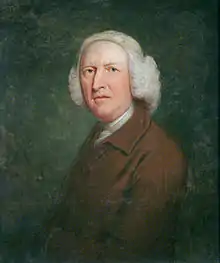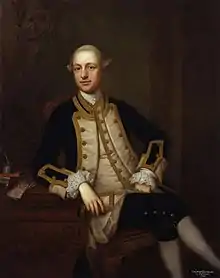

Thomas Bardwell (1704 – 9 September 1767) was an English portrait and figure painter, art copyist, and writer.[1][2]
Life and work
Bardwell initially earned his living initially as a painter of decorative panels for his family's business in Bungay, Suffolk.[3]
His earliest known portraits are two conversation pieces dated 1736; one, possibly showing the Brewster family of Beccles, is in the collection of the Geffrye Museum.[4] In 1746 he was commissioned by the artillery company in Norwich to paint a portrait of William Crowe (who became mayor the following year),[5] breaking the monopoly on civic portraiture in the city held until then by the German-born John Theodore Heins.[6] It became the first of nine portraits by Bardwell that were to be hung in St Andrew's Hall in Norwich.[5]
He painted several portraits in London during the 1740s and 1750s.[3] One, Joshua Ward Receiving Money from Britannia (and Bestowing it as Charity on the Needy) (1748) [7] is an allegorical work, showing Ward, a London doctor, with symbolic figures of Britannia and Charity and a crowd of patients.[7][8] Now in the collection of the Royal College of Surgeons,[7] it once hung in the Ward's parlour in Whitehall.[9] There is an engraving after it, of 1748-9, probably by Bernard Baron.[1]
In 1752-3 Bardwell carried out a large number of commissions in Yorkshire and Scotland. Eventually, in 1759, he settled permanently in Norwich.[3] An obituary in a Norwich newspaper was to describe him as "an eminent portrait painter of this city, who principally through the power of genius and dint of application, acquired a degree of perfection in his art, which would have been deemed excellent, even had it been accompanied with a liberal tuition."[5] According to A General History of the County of Norfolk, published in 1829, "the best of his portraits are at Langley; Mr. Turner and Mr. Carr, both of [Norwich] have historical subjects by him."[5]
Writings
In 1756, a 64-page treatise by Bardwell, entitled The Practice of Painting and Perspective Made Easy, dedicated to the Earl of Rochford, was published, printed by Miller of Bungay.[9] It gives a London address for Bardwell, being advertised as available from the author "at the Golden Lamp, in Rose Street, near the end of Covent Garden".[5] Edward Edwards, writing in 1808, praised the book, despite his generally low opinion of Bardwell as an artist,[10] saying that "the instructions contained in that short work, so far as they relate to the process of painting, are the best that have hitherto been published".[9] He did however, find the part on perspective unsatisfactory.[9] A second edition was published in 1773.[9]
References
- 1 2 "Bardwell, Thomas". Dictionary of National Biography. London: Smith, Elder & Co. 1885–1900. p. 77.
- ↑ Thomas Bardwell (answers.com).
- 1 2 3 "Person - Thomas Bardwell". National Portrait Gallery. Retrieved 25 August 2012.
- ↑ "Group portrait, possibly of the Brewster Family". Geffrye Museum. Retrieved 5 July 2012.
- 1 2 3 4 5 John Chambers (1829). A General History of the County of Norfolk. Vol. 3. Norwich: John Stacy. pp. 1191–3.
- ↑ Moore, Andrew (1985). The Norwich School of Artists. London: HMSO. p. 9.
- 1 2 3 "Joshua Ward Receiving Money from Britannia (and Bestowing it as Charity on the Needy)". Retrieved 5 July 2012.
- ↑ Haslam, Fiona (1996). From Hogarth to Rowlandson: medicine in art in eighteenth-century Britain. Liverpool University Press. pp. 63–4. ISBN 9780853236405.
- 1 2 3 4 5 Edwards, Edward (1808). Anecdotes of Painters. London. p. 7.
- ↑ Edwards viewed Bardwell as basically a copyist, adding that "in his original works he held no very high rank".
Further reading
- M. Kirby Talley. Thomas Bardwell of Bungay, artist and author (Pitman Press for the Walpole Society, 1978).
External links
- 48 artworks by or after Thomas Bardwell at the Art UK site
- Thomas Bardwell on artnet
- Portraits by Bardwell (National Portrait Gallery)
- Paintings by Thomas Bardwell (Art Renewal Centre)
- Group Portrait of the Brewster Family (1736, Art Fund)